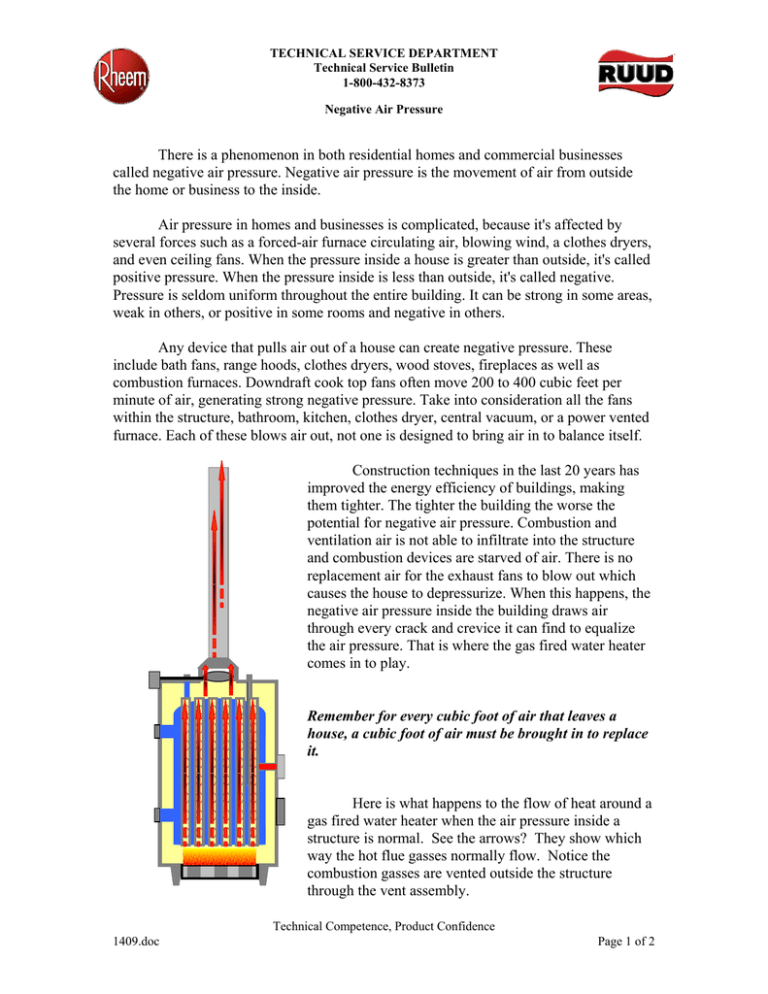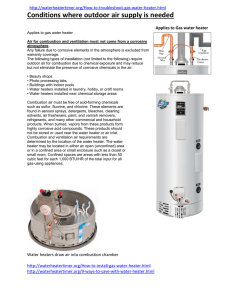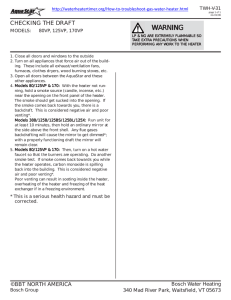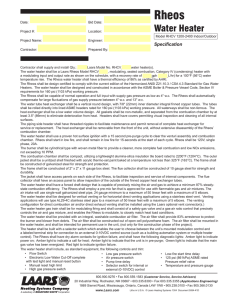Negative Air Pressure
advertisement

TECHNICAL SERVICE DEPARTMENT Technical Service Bulletin 1-800-432-8373 Negative Air Pressure There is a phenomenon in both residential homes and commercial businesses called negative air pressure. Negative air pressure is the movement of air from outside the home or business to the inside. Air pressure in homes and businesses is complicated, because it's affected by several forces such as a forced-air furnace circulating air, blowing wind, a clothes dryers, and even ceiling fans. When the pressure inside a house is greater than outside, it's called positive pressure. When the pressure inside is less than outside, it's called negative. Pressure is seldom uniform throughout the entire building. It can be strong in some areas, weak in others, or positive in some rooms and negative in others. Any device that pulls air out of a house can create negative pressure. These include bath fans, range hoods, clothes dryers, wood stoves, fireplaces as well as combustion furnaces. Downdraft cook top fans often move 200 to 400 cubic feet per minute of air, generating strong negative pressure. Take into consideration all the fans within the structure, bathroom, kitchen, clothes dryer, central vacuum, or a power vented furnace. Each of these blows air out, not one is designed to bring air in to balance itself. Construction techniques in the last 20 years has improved the energy efficiency of buildings, making them tighter. The tighter the building the worse the potential for negative air pressure. Combustion and ventilation air is not able to infiltrate into the structure and combustion devices are starved of air. There is no replacement air for the exhaust fans to blow out which causes the house to depressurize. When this happens, the negative air pressure inside the building draws air through every crack and crevice it can find to equalize the air pressure. That is where the gas fired water heater comes in to play. Remember for every cubic foot of air that leaves a house, a cubic foot of air must be brought in to replace it. Here is what happens to the flow of heat around a gas fired water heater when the air pressure inside a structure is normal. See the arrows? They show which way the hot flue gasses normally flow. Notice the combustion gasses are vented outside the structure through the vent assembly. Technical Competence, Product Confidence 1409.doc Page 1 of 2 TECHNICAL SERVICE DEPARTMENT Technical Service Bulletin 1-800-432-8373 Negative Air Pressure Here is what happens to the flow of heat when there is negative air pressure inside a structure. See the arrows in this diagram? You will notice the flue gasses have reversed direction. You will also notice that the venting assembly has become a fresh air intake source and does not allow the combustion gasses to exhaust properly. As well as poor water heater performance, now there are harmful combustion gasses being pulled into the building. Symptoms of negative air pressure problems could be: • • • • Pilot flame will not stay lit Flame rollout at the bottom of the heater Sooting around the bottom of the heater Slow recovery of the water heater The issue here is not to fix the negative air pressure; after all venting fans over stoves, grease fryers and in bathrooms were put there for a reason. The best solution is to relocate or isolate the water heater to its own environment. Install the water heater in a room or area that is not affected by negative air pressure. Provide a plentiful supply of fresh combustion air and tightly seal the doorframe if the unit is located close to areas using the venting fans. You will normally find the negative air pressure phenomenon in one of two places: Kitchens – because of the venting devices over stoves and grease fryers. Laundry rooms – because of the dryers venting the moist air from the wet clothes to the outside of the building. Technical Competence, Product Confidence 1409.doc Page 2 of 2






